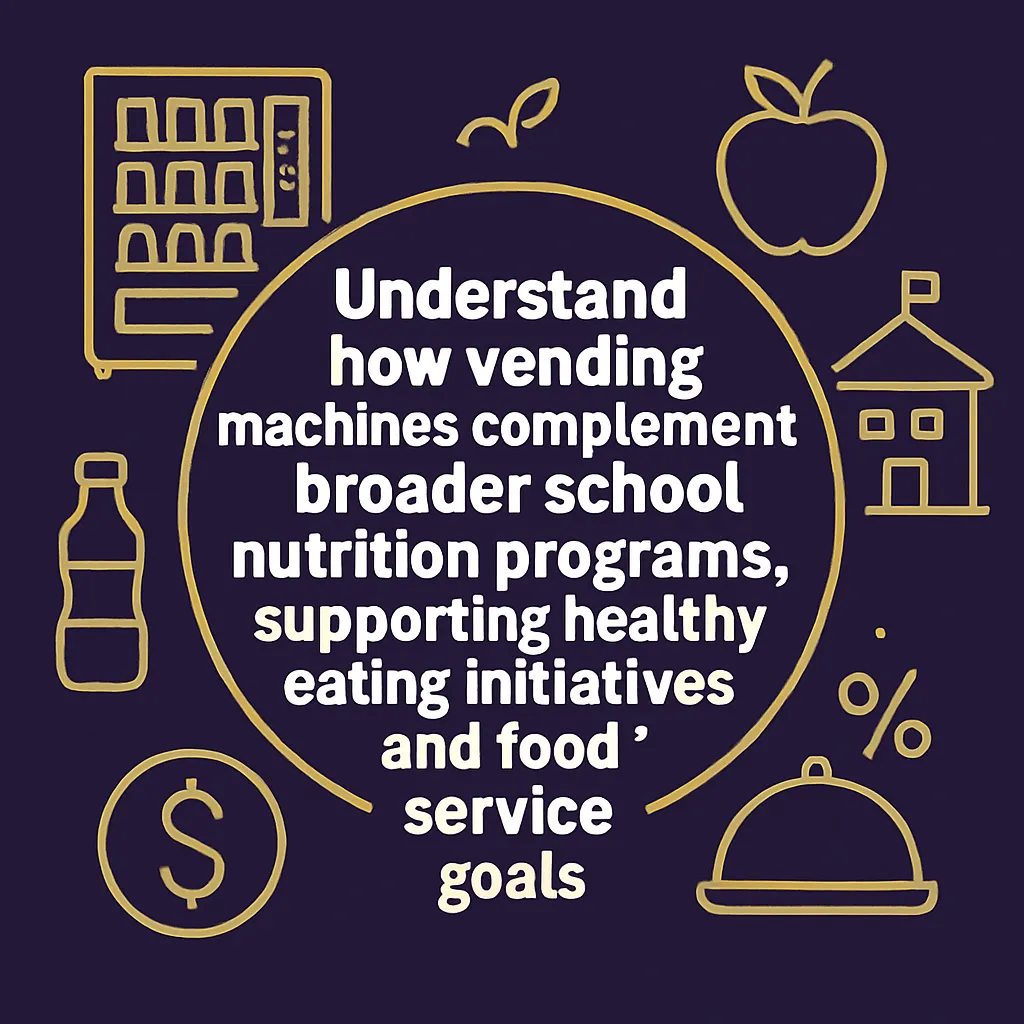The Role of Vending in School Nutrition Programs
Understand how vending machines complement broader school nutrition programs, supporting healthy eating initiatives and food service goals.
Back to Vending for Schools ResourcesUnderstand how vending machines complement broader school nutrition programs, supporting healthy eating initiatives and food service goals.
Back to Vending for Schools ResourcesModern vending solutions can seamlessly integrate into school nutrition programs, offering students convenient access to compliant, healthy food and beverage options throughout the day.
![]() Provides accessible healthy choices aligned with Smart Snacks standards
Provides accessible healthy choices aligned with Smart Snacks standards
![]() Extends healthy eating options beyond traditional cafeteria hours
Extends healthy eating options beyond traditional cafeteria hours
![]() Supports school wellness initiatives with diverse product offerings
Supports school wellness initiatives with diverse product offerings

School nutrition programs are vital for student health, academic performance, and overall well-being. While cafeterias are the cornerstone of these programs, vending machines can serve as a flexible and accessible extension, ensuring students and staff have consistent access to nutritious options throughout the school day and during extracurricular activities. Integrating vending thoughtfully means aligning product selections with federal and state nutrition guidelines, particularly the USDA Smart Snacks standards.
The role of vending in school nutrition is to complement, not replace, traditional meal services. This is achieved by carefully curating product offerings that meet strict nutritional criteria. Modern vending machines can be stocked with healthier choices like fresh fruit, yogurt, whole-grain snacks, and unsweetened beverages. For an in-depth look at these guidelines, you can review current state school vending machine guidelines.
By providing options that adhere to these standards, schools can reinforce positive eating habits and offer convenient alternatives during times when cafeteria services are unavailable, such as after-school programs or athletic events. This approach supports holistic student wellness and ensures that healthy choices are readily available.
The school day often extends beyond lunch breaks and traditional cafeteria hours. Students involved in sports, clubs, or academic support may be on campus for many hours, requiring access to snacks and drinks. Strategically placed vending machines can fill this gap, providing convenient and compliant options. These machines empower students to make healthier independent choices when they need a quick bite or a refreshing drink.
Many schools are choosing to stock machines with products that directly support their nutritional goals. Discover how other institutions achieve this by exploring options like healthy vending compliance for schools. This ensures that every purchasing decision, even from a vending machine, contributes positively to a student's diet.
Implementing vending in schools doesn't have to add to administrative burdens. Vending services typically handle installation, stocking, maintenance, and compliance, freeing up school staff. Furthermore, modern vending solutions offer customization in product selection, allowing schools to tailor offerings to student preferences while maintaining nutritional integrity. Some schools even consider revenue-sharing models from vending to support other school fundraising through vending initiatives or student programs.
For administrators seeking guidance on navigating these options, resources such as a detailed school administrator's guide to vending can be invaluable. This ensures that the integration of vending machines is smooth, compliant, and beneficial for the entire school community.
If you're considering enhancing your school's nutrition program with modern vending solutions, Vending Exchange can connect you with providers specializing in compliant and student-friendly options. Delivery, installation, and equipment are typically provided at no cost, allowing your school to offer convenient, healthy choices without significant upfront investment or ongoing management burden.
Vending machines can complement school nutrition programs by offering convenient access to healthy snacks and beverages that meet USDA Smart Snacks standards, extending healthy options beyond the cafeteria.
USDA Smart Snacks standards are federal guidelines that define what foods and beverages can be sold in schools outside of the reimbursable meal programs, focusing on whole grains, nutrient-rich items, and limited calories, fat, sugar, and sodium.
Yes, modern refrigerated vending machines can offer fresh food options such as fruit cups, yogurt, salads, and wraps, providing nutritious choices for students and staff.
By stocking machines with a variety of compliant healthy snacks and drinks, schools can make better choices more accessible and encourage students to develop positive eating habits.
Schools often benefit from combo vending machines, which offer both snacks and drinks, and intelligent coolers that can be stocked with fresh and healthy items, all while meeting safety standards.
Some schools use vending machines as part of programs to address food insecurity by offering affordable options or providing free access to essential snacks and meals for students in need.
Modern school vending machines often feature cashless payment options, remote monitoring for restocking efficiency, and even AI-powered coolers that offer a wider range of healthy choices with convenient self-checkout.
Yes, vending machines can generate commissions for schools, which can be allocated to nutrition programs, student activities, or other school-wide initiatives, supporting educational goals.
Product selections in school vending machines are typically determined by a combination of USDA Smart Snacks guidelines, state-specific regulations, student preferences, and administrative approval to ensure health and compliance.
Safety considerations include secure placement to prevent tipping, regular maintenance checks, and adherence to electrical and operational safety standards, all crucial for a school environment.